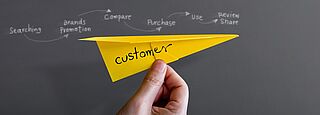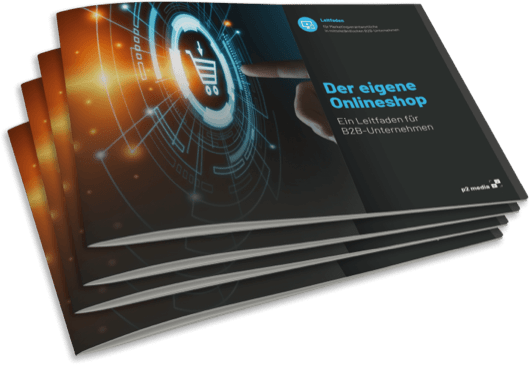All Eyes on the Customer - Today's customer is in a real information overload. In addition, there is a whole new variety of possibilities that he can draw on to solve his needs. He avoids advertising content. So it's all the more important today to make your marketing and sales strategy user-centric - to focus on the customer with all their needs, problems and behaviours.
At the same time, the customer journey, and therefore the decision-making process leading up to the purchase, is a lot more complex than it was just a few years ago. Information is weighed thoroughly and trust as well as the relationship with your company also play a crucial role. So it's essential to think carefully about each touchpoint in the customer journey and make the customer's experience with your business memorable at the relevant points. Maybe even start at a point where the potential customer doesn't even know about his later need..."
Customer Journey
The term "Customer Journey" - especially in the online context also called "User Journey" - basically describes a method under which holistic customer-oriented marketing but also sales processes can be created.
Put simply, the approach considers the buying process journey from the first point of contact (touchpoint) to the purchase and beyond. Typical touchpoints include Google search, advertisements, social media or physical media such as billboards, articles in trade magazines, but also the company logo on the company building, stationery and vehicle lettering.
Ideally, these touchpoints are served by marketing and sales efforts in such a way that customers feel best understood and supported at each one. In the course of this, they can be guided precisely to a desired target action. This is usually the purchase of a product.
user experience
As you can see from the introduction, customer journey and user experience are very closely related in practice - or at least they should be.
At a basic level, the term "user experience" in the sense of online marketing describes the user experience that people have when using a web presence.
How good the user experience is is primarily determined by usability, i.e. the objective user-friendliness of a company website or an online shop in terms of function and technical features. In addition, cognitive aspects, such as the accuracy of the respective customer approach and the content offered and emotions conveyed, also play a role.
User Experience vs. Customer Experience
So what does this have to do with the customer journey? It's relatively easy to explain: Only the optimal service of all touchpoints during the customer journey can ultimately lead to an all-round good user experience.
The terms "user experience" and "customer experience" are often used interchangeably, but they do not actually describe the same thing. User experience refers to the user experience that people experience when using a web presence, and customer experience refers to the customer experience as a whole. The latter includes, among other things, impressions left by general advertising, conveyed company values and other channels away from the online world.
The customer journey is once again a key factor here. Only those who optimally serve the typical touchpoints of their customers on the customer journey can create a maximally positive customer experience - i.e. the highest customer satisfaction - and thus continuously keep customer acquisition and customer loyalty high.
What is a customer journey map?
The customer journey map is the central tool for defining the customer journey of your target customers. It ultimately maps the route that people typically take on the way to a purchase.
This route is determined centrally by the most important touchpoints at which customers come into contact with the brand. This makes the Customer Journey Map extremely helpful in optimally serving the customer journey.
The map provides companies with a comprehensive insight into what customers experience on their customer journey and what experiences they have with the respective brand. These insights are in turn useful for optimizing the customer journey.
How do you create a customer journey map?
In order to create a truly useful customer journey map, the following steps should be considered.
The Customer Journey is, of course, to be considered strictly customer-oriented. The same applies to the Customer Journey Map.
In order to find out what customers need and/or expect, one should therefore by no means rely on assumptions, but proceed data-based. This is the only way to make the customer journey map meaningful and relevant.
The most important data for the customer journey map results from specific web analytics, which reflect the behavior of the users of a website. With the help of appropriate analysis tools, it is possible to understand very precisely how visitors interact with the individual pages and features and where there is potential for optimization.
Furthermore, customer service and direct customer surveys can provide valuable information.
It is worthwhile both to target customer surveys specifically at individual touchpoints in the customer journey and to ask support to ask relevant questions along the way. After all, not all deficits can be determined via web analytics and customers do not always give direct feedback of their own accord when they dislike or like something.
Concrete questions about expectations, needs and purchase decisions can provide a lot of useful insights for optimizing the customer journey.
The buyer persona is the prototype of a customer. It is largely based on the previously described analysis data and helps to better understand the own users. Among other things, the buyer persona summarizes the needs, goals and problems of the customer with regard to the company's services.
And how do you define a Buyer Persona?
Together with the analytics data, the buyer persona forms the foundation of customer journey optimization. Without determining who is going through the buying process, it cannot be improved efficiently.
It is very important to capture exactly what the personas want or need to achieve. Accordingly, challenges or desires in question are at the heart of the target group analysis. The Buyer Persona approach combines these factors with socio-demographic as well as psychological characteristics and other data in profiles of fictitious customer types.
In contrast to the classic target group analysis, customers are depicted much more tangibly and realistically as buyer personas, which means that the customer journey and the entire marketing can be aligned much more efficiently.
The creation of buyer personas can be done under different approaches. It is essential to consider the following aspects.
Background knowledge questions:
- How old is the persona,
- where does she live,
- what does she do for a living,
- what does she earn.
- and does she have a family?
Customer intention - motivation:
- Why does the persona need or want to buy
- and what are the exact motivations for seeking a solution (problems or needs)?
Benefits:
- What benefits does the persona expect to receive through a purchase - personally and/or for their company?
- what benefits are most important to her and what might she like about competitors' offerings?
Objections:
- What might prevent the persona from buying and what might competitors do better?
Once the most important data has been collected and buyer personas defined, the next step is to highlight the various steps that a typical customer goes through in chronological order on the way to making a purchase. Here, a distinction is made between steps and touchpoints.
Touchpoints are the points of contact with the brand created by a company. Steps, on the other hand, refer to various actions or steps that a customer takes on their own initiative during their customer journey. Ideally, touchpoints and steps are perfectly aligned at every point in the customer journey. In order to achieve this, they must first be appropriately compared in a timeline.
Touchpoints and steps are always distributed across different channels. These must also be clearly defined and linked to the buyer personas.
In the best case, it is determined that all touchpoints and steps are optimally harmonized or served across all important channels. In most cases, this reveals deficits, which can, however, be remedied very precisely after this check.
Now it is a matter of identifying when and where the buyer personas feel emotions during their steps and the relevant touchpoints.
The assessment of the emotional situation provides important insights for making the customer journey more personal. This in turn helps to increase the willingness to interact and even brand loyalty.
Not all steps and touchpoints are necessarily equally important for a buyer persona. It depends strongly on the respective challenges, needs and goals of the latter.
Of course, important steps and touchpoints should be particularly promoted. It is therefore important to precisely compare the steps, touchpoints, customer needs and general buying behavior and to identify the most relevant connections.
What do the different phases of a user journey look like?
The User Journey is a variation of the Customer Journey. It refers specifically to the requirements in the online sector and extends the "AIDA" model. With the latter, the classic CJ phases are usually mapped. It resembles a funnel, which in the ACCRA model can be divided into five touchpoints.These CJ phases are accompanied by specific customer-facing steps. Typical steps of the individual phases are as follows.
The interest of a user is stoked so that he has the desire to use the services of the company.
Because sustainable and fair practices are important to the searching company, they inform themselves specifically in this direction. All companies that offer touchpoints to these requirements are shortlisted.
Conclusion
The huge choice that the web offers today in almost all industries means that companies have to care all the more about a holistic ideal support of their target customers. The customer journey approach and its optimization can contribute significantly to the success of this.
When drawing up a customer journey map, important decision points for or against one's own products are identified very precisely. On this foundation, in turn, the customer experience that one's own target group desires is to be created. Those who do everything right here take a huge step towards long-term customer loyalty.
A good user experience is the linchpin here. The businesses that consistently provide a positive experience to their customers will be taken up in the long run. And serving target customers optimally at every point of the customer journeyalways forms a central factor in maximizing the user experience.
Our support around the topic Customer Journey:
- Together with you, we create relevant customer profiles and derive a professional customer journey.
- We determine relevant channels and design an individual customer journey map specifically for your company.
- Based on this, we outline a positiveuser experience along all relevant touchpoints and implement it programmatically.
- In addition, we are happy to support you in the strategic alignment of lead nurturing with the defined customer journey and develop concrete content modules for the respective phases of the buying process.
For holistic and successful online marketing, we are also happy to take care of the following topics:
Oliver Parrizas will be happy to answer any questions you may have on the subject. +49-800-911-91-91













